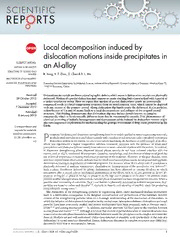
Local decomposition induced by dislocation motions inside precipitates in an Al-alloy. PDF
Preview Local decomposition induced by dislocation motions inside precipitates in an Al-alloy.
Local decomposition induced by dislocation motions inside precipitates in SUBJECTAREAS: an Al-alloy METALSANDALLOYS STRUCTUREOFSOLIDSAND LIQUIDS B.Yang,Y.T.Zhou,D.Chen&X.L.Ma MECHANICALENGINEERING SURFACES,INTERFACESAND ShenyangNationalLaboratoryforMaterialsScience,InstituteofMetalResearch,ChineseAcademyofSciences,WenhuaRoad72, THINFILMS 110016Shenyang,China. Received Dislocationsincrystalsarelinearcrystallographicdefects,whichmoveinlatticewhencrystalsareplastically 28October2012 deformed.Motionofapartialdislocationmayremoveorcreatestackingfaultcharacterizedwithapartialof alatticetranslationvector.Herewereportthatmotionofpartialdislocationsinsideanintermetallic Accepted compoundresultinalocalcompositiondeviationfromitsstoichiometricratio,whichcannotbedepicted 7December2012 withanyvectorsoftheprimarycrystal.AlongdislocationslipbandsinsidethedeformedAl Cuparticles, 2 redistributionofCuandAlatomsleadstoalocaldecompositionandcollapseoftheoriginalcrystal Published structure.Thisfindingdemonstratesthatdislocationslipmayinducedestabilizationincomplex 8January2013 compounds,whichisfundamentallydifferentfromthatinmonometalliccrystals.Thisphenomenonof chemicalunmixingofinitiallyhomogeneousmulticomponentsolidsinducedbydislocationmotionmight alsohaveimportantimplicationsforunderstandingthegeologicevolvementofdeep-focusperidotitesinthe Earth. Correspondenceand requestsformaterials shouldbeaddressedto Precipitatehardeninganddispersionstrengtheninghavebeenwidelyappliedinmanyengineeringmaterials, X.L.M.([email protected]. inwhichsmallparticlesofsecondphase(usuallywithcomplexcrystalstructure)playcriticalroleinresisting cn) dislocationmotioninthematrix.Incaseofprecipitatehardening,thehardnessoryieldstrengthofanalloy, which was experienced a higher temperature solution treatment, increases with the presence of small-sized precipitationandtheseprecipitatesusuallyhavecoherentorsemi-coherentinterfacewiththematrix.Incontrast, in dispersion strengthening alloys, dispersed second phases usually do not have coherent interface with the matrix,suchasAl O -reinforcedAlcomposites.Quantity,morphology,anddistributionofthesesmallparticles 2 3 areofcriticalimportanceintuningmechanicalpropertiesofthematerials.However,inthepastdecades,more andmoreexperimentalobservationsindicatethatthesmall-sizedsecondphasecanbedecomposedduringplastic deformation,leadingtodegradationofmaterialproperties.Forinstance,whenAl-Cualloyswithh’precipitateis plasticallydeformedatambienttemperature,dissolutionordecompositionoftheprecipitateswasdetected1,2. Such a phase dissolution induced by plastic deformation has been observed in various Al-alloys in which precipitatesplayacrucialroleinmechanicalperformanceofthealloys,suchasAl Fe particleinAl-Fe3,b’- 13 4 phaseinAl-Mg-Si4,c’-phaseinAl-Ag5,g’-phaseinAl-Zn-Mg6andd’-phaseinAl-Lialloy7,8.Inaddition,steels provideanotherexamplewheredeformation-inducedphasedissolutionhasbeenrecognizedfordecades.Whena pearliticsteel(consistingofcementite(Fe C)andferrite)isplasticallydeformedatambienttemperature,Fe C 3 3 particlesarefoundtorefineanddissolve9–12,typicallyinheavilycolddrawingofpearliticsteelsforproducing extraordinarilystrongwires13. Thedissolution ofthestrengthening particles inengineering alloysunder mechanical loadingunavoidably leadstoadetrimentalconsequenceinthedesignedmicrostructureandperformanceofthematerials.Stability controlofthestrengtheningparticlesreliesonathoroughunderstandingofthemechanismofdissolution,in whichthebehaviorofdislocationsisbelievedtobethecentralissue.Interactionsbetweendislocationsandsmall particles have been extensively studied and several mechanisms have been proposed, such as Orowan mech- anism14–16andcuttingmechanism17,18.Inaddition,particularattentionhasbeenpaidtotheinterfacebetween secondphaseandmatrix9–11,19–22.Althoughitisknowthatmotionofpartialdislocationinorderedstructuresmay removeorcreateanti-phaseboundaries,dislocationbehaviorsinsidetheprecipitateswithcomplexstructureslike thoseinAl-alloysarenotwellunderstood.Dislocationstructureatatomisticscale(particularlyatthecoreofa dislocation)iscrystalstructure-dependent.Hence,dislocationdynamicsincomplexstructuresmaydifferfun- damentallyfromthatinmonometalliclattices. SCIENTIFICREPORTS |3:1039|DOI:10.1038/srep01039 1 www.nature.com/scientificreports Figure1|(a)HAADFimageshowingthemicrostructuralcharacteristicsoftheas-receiveddual-phasematerial.TheparticlesembeddedinAlmatrixare tetragonalh-Al Cuprecipitates,verifiedbyX-raydiffractionandaseriesofelectrondiffractionpatterns.(b)HAADFimageofanareawithinasingle 2 crystallineAl Cuprecipitatealong[001]crystallographicdirection(seeinset).(c)and(d)areelementalmapsofAlandCu,respectively,correspondingto 2 theareasquaredin(b).BothAlandCuarehomogeneouslydistributed.(e)Micrographshowinganarrayofdislocationsintheprecipitateinducedby deformation.(f)Bright-fieldTEMimageshowingslipbandson(110)crystallographicplanesinanAl Cuparticle.(g)HAADFimageofthesameareaas 2 thatin(f)showsclearcontrastvariationalongtheslipband.Thebottom-leftinsetisasectionalongthisslipbandmarkedwithblackrectangle.Theup-left insetisanEDPof[110]zoneaxisfromtheareamarkedwithablackcircle. Results confirmed by the homogeneous contrast of the high-angle-angu- WechoseanAl-4wt.%Cualloyinthisstudy.Thealloyexperienceda lar-dark-field(HAADF) imageinTEM(Fig. 1b),aswellasbythe solution treatment at 520uC followed by ageing at 300uC for electrondiffractionpattern(InsetinFig.1b).ItisnotedthatHAADF 48 hours,asshowninFig.S1.Theas-receivedsampleiscomposed images provide strong contrast associated with the local variety of of tetragonal h-Al Cu precipitates embedded in Al matrix, Fig. 1a chemical compositions and/or thickness contribution23. Elemental 2 and Fig. S2. Each of the Al Cu precipitates is a single crystal, as mapsofAlandCuinthesinglecrystallineAl Cu(Fig.1c,1d)show 2 2 Figure2|(a)HAADFimageofasectionalongatypicalslipband.ItisseenthatthemorphologyofCu-richareasrangesfromcirculartoelliptical,and sometimesirregular.(b)and(c)areAlandCumaps,respectively,obtainedfromtheareamarkedwithawhiterectanglein(a).Adarkerringin(b) correspondingtothebrighterringin(c)ispoorofAlandrichofCu.(d)isEDSprofilesshowingthelocalcompositionfluctuationalongtheslipband. ThescanningrouteforthisEDSprofileisperpendiculartotheslipbandmarkedwithawhiteverticallinein(a).(e)Cu-mapalongtheslipband,wherethe intensityofCuisvaried.(f)[110]EDPtakenintheareaclosetotheslipband.(g–i)EDPstakenatdifferentCu-poorareasalongtheslipband.TheseEDPs canbenolongerindexedtotetragonalAl Cuduetodecompositionandstructuralcollapse. 2 SCIENTIFICREPORTS |3:1039|DOI:10.1038/srep01039 2 www.nature.com/scientificreports Figure3|(a)HREMimageobtainedfrom[110]directionshowingadislocationarraywithaslipsystem[001](110).Burgerscircuitisoutlinedforeach dislocation,whichexhibitsthelatticedisplacementof1/2[001]inthisprojection.(b)Highmagnificationimageofthepartialdislocation(leftpartialin (A)).Stackingfaultintherightofdislocationcore(‘‘H’’)isnotresolvedsincetheatomicprojectionsof(001)and1/2(001)planesarethesame. (c)Atomicstructuralmodelofthepartialsviewedalongthedislocationline.Here,atomsinthreesub-layers(x50,0.096,0.25)areselectedforprojection inordertodistinguishthetwocores.Thepartialchangesthestackingofthecrystal(verticaldirectioninthisschematicrepresentation),i.e.iteither removesorcreatesastackingfault.Thewholeconfigurationoftwopartialsandstackingfault(anellipsisbetweentwocoresaremarked)iscalledan extendeddislocation. aratherhomogeneousdistributionofbothelements.Compositional Semi-quantitativecharacterizationofthecompositionvariations fluctuations in the measured areas are within 65,68 at% Al and inadeformedAl Cuparticleisperformedbyelementalmappingand 2 correspondingly31,35at%Cu. X-ray energy dispersive spectrometer (EDS) analysis. Local areas Plastic deformation of the sample was performed by using the withacontrastinhomogeneityalongtheslipbandintheHAADF surface mechanical attrition treatment (SMAT) under vacuum of imageareselected(Fig.2a),withaparticularattentiontotheAland 631022 Pa at liquid nitrogen temperature for 60 minutes with a Cudistribution.Theelementalmapsoftheareamarkedwithawhile vibratingfrequencyof50 Hz.SMATproducesagradientvariation rectangle in Fig. 2a are shown in Fig. 2b and 2c. In the Al map ofplasticstrain(andstrainrate)inthetreatedsurfacelayer24–26.The (Fig.2b),adarkerringisobserved.Atthecorrespondingposition, overalldeformationlayerintheSMATsampleisabout40mmthick aring with brightercontrast is seen in theCu map(Fig. 2c). This (Fig. S3), in which Al Cu particles at different depths from the meanstheringareaispoorofAlandrichofCu.SuchaCusegrega- 2 treatedsurfacearedeformedwithdifferentplasticstrains.TEMana- tionleavesaCu-poorareainitsvicinity.Furthermore,EDSprofiles lysisindicatesthat,inadditiontotheAlmatrix,Al Cuprecipitates (Fig.2d)scannedalongtheverticallineinFig.2aalsoindicatethata 2 are also plastically deformed and strain-induced dislocations are composition fluctuation happened. The wavy counts indicate a observed inside the precipitates (Fig. 1e). Semi-quantitative X-ray remarkablejumpofchemicalcompositions.Detailedstatisticmea- diffractionanalysiswithalowscanningangleof3ushowsthatthe surementsfromadozenofEDSspectraindicatethatthecomposition volumefractionofAl Cuprecipitatesinthetopmostdeformedlayer intheCu-richareasrangeswithin38,46at%Cuand53,62at%Al. 2 (of about 2 mm thick) is reduced by 35.6% after SMAT (Fig. S4), ThiscorrespondstoAl/Curatioof1.16,1.63,deviatedpronounc- indicatingthatalargevolumeoftheprecipitateshasbeendissolved edly from the Al Cu stoichiometric ratio (251). By comparison of 2 asaresultofheavyplasticdeformationinthetopmostlayer. HAADF images and thecorresponding EDSprofiles, onemay see Inthedeepdeformedlayer(30,40mmfromthetreatedsurface), thattheareawithabrighterHAADFcontrastisalwaysrichofCu, presenceofslipbandsalong(110)crystallographicplaneinsidethe whilethedarkerareaispoorofCu.Suchanelementalredistribution deformed Al Cu particles is one of the salient features, as seen in canbeoverviewedclearlyinaCumapping(Fig.2e),whereCu-rich 2 bright-field TEM images (Fig. 1f). HAADF image (Fig. 1g) of the andCu-poorareasarealternatelypresentalongtheslipband. sameareaasthatinFig.1fshowsthatthecontrastalongtheslipband A series of electron diffraction experiments were carried out to is rather inhomogeneous (the most remarkable areas are up-ward identify the structural evolution in the area corresponding to the arrowed).Thissignifiesthatthechemicalcompositionalongtheslip decomposition.Forcomparisons,the[110]electrondiffractionpat- bandisdeviatedfromthatofunformedstate.Acloseobservation,as tern(EDP)takenintheareaclosetotheslipbandisshown(Fig.2f). in theinset ofFig. 1g, reveals a more distinct contrast where each It is interesting to note that when electron beam is shifted in a darkerareaisattachedwithabrighterellipticaldomain. parallel approach to the Cu-poor areas along the slip band, the SCIENTIFICREPORTS |3:1039|DOI:10.1038/srep01039 3 www.nature.com/scientificreports Figure4|(a)SchematicofthecomputationalcellusedforMDsimulations.Thedislocationisindicatedwith‘‘H’’;andthestackingfaultarea(intheleft ofthecore)isalsomarked.(b)CellforMDsimulation,wherepartialdislocationisinvolved.(c–e)Snapshotsoftheatomicconfigurationat14,000, 200,000,and400,000timesteps,respectively.In(b–e),thegreenspheresdenoteAlandthebrownspheresCuatoms,respectively.(f)Atomistic configurationsprojectedalong[110]directionwhereperfectarea,partialcore,andstackingfaultarerepresented.(g)and(h)showacontinuousmotion ofdislocationleavesbehindCudisplacements(red-arrowed)aroundtheslipplane.(i–m)MDsimulationindicatesthatthetwopartialstendtomove towardeachother(seethelengthchangingofthedouble-arrowedbarsinthefigure).Coloredaccordingtothedisplacementvalues(pffidffiffixffiffi2ffiffizffiffiffiffiffidffiffiyffiffiffi2ffizffiffiffiffiffidffiffiffizffiffi2ffiffi), theplotsdisplayanevolutionofCudisplacementat6,000,10,000,16,000,30,000,and240,000timesteps,respectively.In(i–l),thedisplacementvaluesare from0to1A˚;whilein(M)therangeis0,7A˚.Theadditionalpeaksbetweenthetwopartialsin(j,k,l)arebelievedtoresultfromthelocaldistortionunder stressinthestackingfaultarea. EDPsdisplaycompletelydifferentcharacteristics(Figs.2g–2i).The inbetween.Theseparationdistancebetweentwopartialsisinarange EDPscanbenolongerindexedtotetragonalAl Cu.Inotherwords, of10,20nm.TheleftpartialinFig.3aismagnifiedasseeninFig.3b, 2 1 dislocationmotionalongtheslipbandinsidetheAl2Cuprecipitate wherealatticedisplacementof [001]canbeidentifiedinthispro- resultsinnotonlychemicaldecompositionbutalsoalatticestruc- 2 jection. The tetragonal Al Cu crystal has eight sub-layers stacked ture collapse, which differs fundamentally from the scenario in 2 along ,110. direction, namely, A B CB A B CB (schematically monometalliccrystals. 1 1 2 2 2 1 showninFig.S5).Aluminumatomsinlayer‘‘A’’formanetworkof hexagonsandthealuminumatomsinadjacentlayer‘‘B’’islocated Discussion abovethehexagonalcenters.Layer‘‘C’’constitutedofcopperatoms Dislocation characteristics in the body-centered tetragonal Al Cu 2 positionedbetweentwo‘‘B-layer’’.Thepuckered‘‘BAB’’layerscan crystal have been studied earlier by diffraction contrast analysis beconsideredasasandwichstructure,andaglidingby1/2[001]will andhigh-resolutionimaging27,28.DislocationswithBurgersvectors 1 resultintheatomsinlayer‘‘B’’movetotheedgesofhexagonsoflayer of ,111.,[001],and[100]wereidentified,andfaultson(110)and ‘‘A’’,whichshouldbeextremelyunstable.Thusaslipshouldoccur 2 (001)planeswerealsoobserved.InourSMATsample,dislocations between‘‘B’’and‘‘C’’layers.Basedonthisreasoning,thecorestruc- associatedwiththeslipsystemof[001](110)arefrequentlyobserved. tureateachpartialisproposedasshowninFig.3c,whereatomsin Highresolutionimaging(Fig.3a)indicatesthatsuchadislocationis threesub-layersareillustrated(anellipsisisintroducedinthestack- usuallydissociatedintotwopartialdislocationswithastackingfault ingfaultsareabetweentwocores). SCIENTIFICREPORTS |3:1039|DOI:10.1038/srep01039 4 www.nature.com/scientificreports Detailedmoleculardynamical(MD)simulationswereperformed thetop.ATecnaiG2F30transmissionelectronmicroscope,equippedwithHAADF totherightpartialinFig.3ainordertomonitoratomisticprocesses detectorandX-raydispersivespectrometersystems,wasusedat300kVfordiffrac- tion,HAADFimaging,andcompositionanalysis.MDsimulationswithLarge-scale during dislocation motion. In the computational cell used in MD Atomic/MolecularMassivelyParallelSimulator(LAMMPS),areperformedusingthe simulations(Fig.4a),thepartialdislocationiscreatedbyremoving embeddedatommethod(EAM)interatomicpotential. twoadjacentatomichalfplanesfromthecrystalstructure(Fig.4b). Underastress,inFig.4a,theTopatomsaregivenasetvelocityalong 1. Murayama,M.,Horita,Z.&Hono,K.Microstructureoftwo-phaseAl–1.7at%Cu yaxisbuttheBottomatomsarefixed.Inthissystem,thegenerated alloydeformedbyequal-channelangularpressing.ActaMater.49,21–29(2001). stress propagates from the Top to the dislocation on the central 2. Hutchinson,C.R.etal.Quantifyingthestrain-induceddissolutionofprecipitates plane.Atthefirststageofsimulation,thedislocationisabletomove inAlalloymicrostructuresusingnuclearmagneticresonance.ActaMater.57, withthehelpofstressontheslipplane(110)along[001]direction. 5645–5653(2009). 3. Senkov,O.N.etal.MicrostructureandmicrohardnessofanAl-Fealloysubjected Themotionhappens viashiftingverticalrowsofatomsrelativeto tosevereplasticdeformationandaging.Nanostruct.Mater.10,691–698(1998). eachotherontheupperhalfoftheslipplane.Withanincreasingof 4. Cabibbo,M.,Evangelista,E.&Vedani,M.Influenceofsevereplasticdeformations timesteps,stress-induceddistortionbecomesmoreandmoresevere onsecondaryphaseprecipitationina6082Al-Mg-Sialloy.Metall.Mater.Trans. from14,000(Fig.4c),200,000(Fig.4d),to400,000timesteps(Fig.4e) A36,1353–1364(2005). 5. Horita,Z.etal.Achievinghighstrengthandhighductilityinprecipitation- wherealocalizedCu-segregationwith‘‘eyebrow-like’’configuration hardenedalloys.Adv.Mater.17,1599–1602(2005). emerges. Such a local lattice disorder can be also characterized by 6. Xu,C.,Furukawa,M.,Horita,Z.&Langdon,T.G.InfluenceofECAPon measuringthecentrosymmetryparameter(Fig.S6).Themaximum precipitatedistributionsinaspray-castaluminumalloy.ActaMater.53,749–758 ratioofCuquantityperunitvolume(A˚3)intheCu-richtotheCu- (2005). poorareasinFig.4egetsto2.5approximately. 7. Lendvai,J.,Gudladt,H.J.&Gerold,V.Thedeformation-induceddissolutionofd9 precipitatesinAl-Lialloys.ScriptMetall.22,1755–1760(1988). Stackingfaultbetweentwopartialdislocationscanbeconsidered 8. Berchet,Y.,Louchet,F.,Marchionni,C.&Verger-Gaugry,J.L.Experimental(TEM asaplate-like‘‘precipitate’’,whichestablishesanewbondinglength andSTEM)investigationandtheoreticalapproachtothefatigue-induceddissolution andchangesthedspacingsofplanesparalleltotheslipplane29.In ofd9precipitatesina2.5wt%Al-Lialloy.Philos.Mag.A56,353–366(1987). other words, stacking fault in an extended dislocation results in a 9. Gavriljuk,V.G.Decompositionofcementiteinpearliticsteelduetoplastic deformation.Mater.Sci.Eng.A345,81–89(2003). changeoflocalmassdensity.Insuchacase,themotionofdislocation 10.Languillaume,L.,Kapelski,G.&Baudelet,B.Cementitedissolutioninheavilycold inside a complex compound may aggravate the lattice distortion. drawnpearliticsteelwires.ActaMater.45,1201–1212(1997). Once the atomistic displacement happens, it becomes more and 11.Ivanisenko,Yu.,Lojkowski,W.,Valiev,R.Z.&Fecht,H.J.Themechanismof moresevereunderstressuntilphasedecomposition occursviaCu formationofnanostructureanddissolutionofcementiteinapearliticsteelduring highpressuretorsion.ActaMater.51,5555–5570(2003). segregation. On the basis of the MD simulations, a continuous 12.Zhou,L.,Liu,G.,Ma,X.L.&Lu,K.Strain-inducedrefinementinasteelwith development of atomistic configuration versus dislocation motion spheroidalcementitesubjectedtosurfacemechanicalattritiontreatment.Acta ataninitialstageisschematicallyillustrated(Fig.4f–h),whereatoms Mater.56,78–87(2008). inalltheeightsub-layersareprojectedalong[110]direction. 13.Embury,J.D.&Fisher,R.M.Thestructureandpropertiesofdrawnpearlite.Acta Metall.14,147–159(1966). Acomputationalcellwith22912atomswassetuptomonitorthe 14.Orowan,E.SymposiumInternalSreessesinMetalsandAlloys(InstituteofMetals, motionsoftheextendeddislocation(twopartialsareembeddedinthe London)451–453(1948). cell). The MD simulation indicates that the equilibrium separation 15.Kelly,A.&Nicholson,R.B.Precipitationhardening.Prog.Mater.Sci.10,151–391 distanceofthetwopartialsis14.4nmafteroptimization.Similarto (1963). thesimulationsofonepartialinFig.4a–e,Cudisplacementon(110) 16.Bacon,D.,Kocks,U.&Scattergood,R.Theeffectofdislocationself-interactionon theOrowanstress.Philos.Mag.28,1241–1263(1973). planebecomesmoreandmoreremarkablewithincreasingthetime- 17.Gleiter,H.&Hornbogen,E.BeobachtungderWechselwirkungvonVersetzungen steps,seen inFig.4i–lwhichare colored accordingtothe displace- mitkoha¨rentengeordnetenZonen(II).Phys.Stat.Sol.(b)12,251–264(1965). ment values. In the meanwhile, the two partials tend to contract 18.Gerold,V.&Haberkorn,H.Onthecriticalresolvedshearstressofsolidsolutions under a shear stress (double-arrowed bars in Fig. 4i–l), and finally containingcoherentprecipitates.Phys.Stat.Sol.(b)16,675–684(1966). 19.Srolovitz,D.J.,Petkovic-Luton,R.A.&Luton,M.J.Edgedislocation-circular combinedtogetherat240,000timestepsleavingastripofCudisplace- inclusioninteractionsatelevatedtemperatures.ActaMetall.31,2151–2159(1983). ment (yellow together with red in Fig. 4m). The contraction of 20.Gridnev,V.&Gavrilyuk,V.Cementitedecompositioninsteelunderplastic extended dislocations might lower their kinetic energies enough to deformation(areview).Phys.Metals4,531–551(1982). offset the stacking fault energies thatdeterminetheirextensions, as 21.Shabashov,V.A.etal.Deformation-inducedphasetransitionsinahigh-carbon proposedtheoreticallyforf.c.ccrystals30.ThedimensionofsuchaCu- steel.Mater.Sci.Eng.A346,196–207(2003). 22.Sauvage,X.&Ivanisenko,Y.Theroleofcarbonsegregationonnanocrystallisation displacementregionisnearlythesameasthedistancebetweentwo ofpearliticsteelsprocessedbysevereplasticdeformation.J.Mater.Sci.42, partialspriortodislocationmotion(schematicallyillustratedinFig. 1615–1621(2007). S7).Thatistosay,thefinaldegreeofCusegregationdependsonthe 23.Pennycook,S.J.StructuredeterminationthroughZ-contrastmicroscopy. widthofextendeddislocationinrealmaterials.TheCudisplacements Advancesinimagingandelectronphysics123,173–206(2002). 24.Lu,K.&Lu,J.Surfacenanocrystallization(SNC)ofmetallicmaterials- withmaximumvalues(redinFig.4m)arebelievedtocorrespondto presentationoftheconceptbehindanewapproach.J.Mater.Sci.Tech.15, Cu-poordomainsinFig.1andFig.2. 193–197(1999). Dislocationsexistinvariouskindsofmaterialsincludingmetals, 25.Tao,N.R.etal.AninvestigationofsurfacenanocrystallizationmechanisminFe alloys,compounds,ceramics,andpolymers.Ourfindingunambigu- inducedbysurfacemechanicalattritiontreatment.ActaMater.50,4603–4616 (2002). ouslydemonstratesthatdislocationmotionsincomplexcompounds 26.Tong,W.P.etal.Nitridingironatlowertemperatures.Science299,686–688(2003). mayleadtodecompositionandstructuralcollapsearoundtheslip 27.Belgacem,C.H.etal.HRTEMobservationofa,113.hlowangletiltboundary planes,whichdiffersfundamentallyfromthatinmonometallicsys- intheAl–Al2Cu(h)eutecticcomposite.Phys.Stat.Sol.(a)189,183–196(2002). tems. The spatial coupling of dislocation slip and compound dis- 28.Bonnet,R.&Loubradou,M.CrystallinedefectsinaBCTAl2Cu(h)singlecrystal obtainedbyunidirectionalsolidificationalong[001].Phys.Stat.Sol.(a)194, solution is of significance in advancing our understanding of the 173–191(2002). processing-propertyrelationshipinmaterials,andalsoinoptimizing 29.Ferreira,P.J.&Mu¨llner,P.Athermodynamicmodelforthestacking-faultenergy. mechanical properties of engineering materials by means of con- ActaMater.46,4479–4484(1998). trolledplasticdeformationprocessing. 30.Gilman,J.J.Contractionofextendeddislocationsathighspeeds.Mater.Sci.Eng. A319–321,84–86(2001). Methods AnAl-4wt.%Cualloywasselectedandexperiencedasolutiontreatmentat520uC followedbyageingat300uCfor48hours,theas-receivedsampleiscomposedof Acknowledgements tetragonalh-Al2CuprecipitatesembeddedinAlmatrix.X-raydiffractionsatlower WethankProfessorK.LuforthecriticalcommentsonthisworkandMr.X.Shiforhis scanningangleof3uwereperformedtodeterminephasesinthe2mmthicklayerfrom assistanceinsampletreatmentandMr.S.C.WangforhisassistanceinX-raydiffraction. SCIENTIFICREPORTS |3:1039|DOI:10.1038/srep01039 5 www.nature.com/scientificreports ThisworkissupportedbytheNationalNaturalFoundationofChinaandMinistryof Competingfinancialinterests:Theauthorsdeclarenocompetingfinancialinterests. Science&TechnologyofChina(2009CB623705). License:ThisworkislicensedunderaCreativeCommons Attribution-NonCommercial-NoDerivs3.0UnportedLicense.Toviewacopyofthis Authorcontributions: license,visithttp://creativecommons.org/licenses/by-nc-nd/3.0/ X.L.M.designedtheoverallstudyandwrotethepaper.TEMexperimentswereperformed Howtocitethisarticle:Yang,B.,Zhou,Y.T.,Chen,D.&Ma,X.L.Localdecomposition byB.Y.andY.T.Z.(equallycontributedintheexperiments).D.C.carriedoutthetheoretical inducedbydislocationmotionsinsideprecipitatesinanAl-alloy.Sci.Rep.3,1039; calculations.Allauthorscontributedtothediscussionofthedata. DOI:10.1038/srep01039(2013). Additionalinformation Supplementaryinformationaccompaniesthispaperathttp://www.nature.com/ scientificreports SCIENTIFICREPORTS |3:1039|DOI:10.1038/srep01039 6
